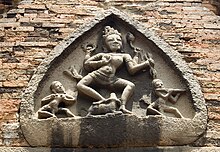Po Nagar
| Po Nagar | |
|---|---|
|
Main temple of the goddess Yan Po Nagar |
|
| Start of building: | 11th century |
| Style elements : | Cham architecture |
| Tower height: |
32 m |
| Location: | 12 ° 15 '55 " N , 109 ° 11' 44" E |
| Location: |
Nha Trang Khánh Hòa , Vietnam |
| Purpose: | Hindu temple |
Po Nagar is a former Hindu temple complex of the Champa Empire in Nha Trang , a coastal city in southern Vietnam . The temple complex was founded by the Cham around the middle of the 8th century , expanded in the 9th century and rebuilt after its destruction in the 11th century. The main temple ( Cham language : kalan ) from the 11th century is the last major building of Cham architecture .
It is named after the local patron goddess Po Nagar , also Yan Pu Nagara . It is related to the Cham fertility goddess Uroja ("mother's breast"), the creator deity appearing in the form of a snake ( naga ) and with the Indian goddess Bhagavati (also Durga ), the wife of Shiva . The location of the temples directly above the sea also creates a relationship with the Indonesian divine Queen Nyai Loro Kidul.
Temple goddess
The goddess worshiped in the temple complex has many names. It can be seen in connection with the Khmer culture , which finds its climax in Angkor Wat . In Vietnamese the goddess is worshiped as Thiên Y Thánh Mâu . Countless Vietnamese legends surround the goddess Thiên Y Thánh Mâu and her temple. To this day Thiên Y Thánh Mâu is the city goddess of Nha Trang .
Building

A stele dated to the year 781 AD shows that the King of the Cham, Satyavarman, restored a ruined temple after restoring his power in the region of present-day Nha Trang.
The facility was built from burnt red bricks on a hill and overlooks the mouth of the Song Cai River in the South China Sea . It consists of a meditation hall at the foot of the hill and four individual temples, which are dedicated to the Hindu gods Hanuman , Ganesh , Shiva and Yan Po Nagar. The tower of the main temple has a height of about 32 meters.
The entire system was extensively restored and is now in very good condition.
literature
- Herbert Härtel , Jeannine Auboyer: India and Southeast Asia. (Propylaen Art History, Volume 21) Propylaen, Berlin 1985, p. 291
- Annaliese Wulf: Vietnam. Pagodas and temples in the rice field in the focus of Chinese and Indian culture. DuMont, Cologne 1991, pp. 270, 294, 449
Web links
Individual evidence
- ↑ Douglad JW O'Reilly: Early civilizations of Southeast Asia. (Archeology of Southeast Asia) Altamira Press, Lanham 2006, p. 139, ISBN 978-0759102798
- ^ Roy E. Jordaan: The Mystery of Nyai Lara Kidul, Goddess of the Southern Ocean. In: Archipelago . Volume 28, 1984. p. 106
